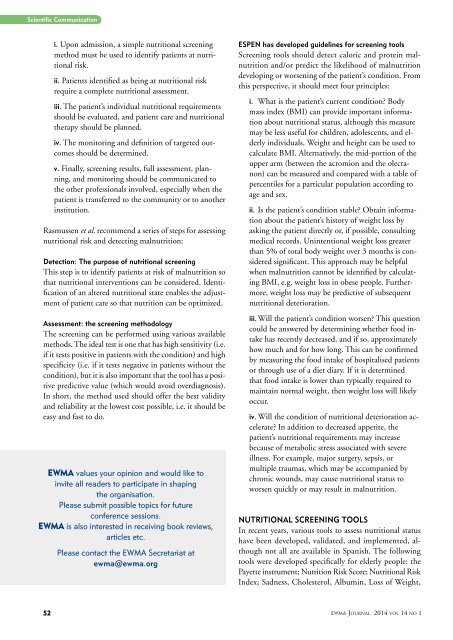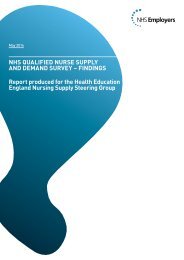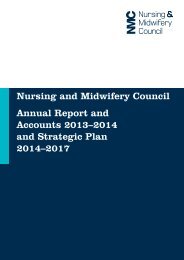Journal_1_2014_final_WEB
Journal_1_2014_final_WEB
Journal_1_2014_final_WEB
You also want an ePaper? Increase the reach of your titles
YUMPU automatically turns print PDFs into web optimized ePapers that Google loves.
Scientific Communication<br />
i. Upon admission, a simple nutritional screening<br />
method must be used to identify patients at nutritional<br />
risk.<br />
ii. Patients identified as being at nutritional risk<br />
require a complete nutritional assessment.<br />
iii. The patient’s individual nutritional requirements<br />
should be evaluated, and patient care and nutritional<br />
therapy should be planned.<br />
iv. The monitoring and definition of targeted outcomes<br />
should be determined.<br />
v. Finally, screening results, full assessment, planning,<br />
and monitoring should be communicated to<br />
the other professionals involved, especially when the<br />
patient is transferred to the community or to another<br />
institution.<br />
Rasmussen et al. recommend a series of steps for assessing<br />
nutritional risk and detecting malnutrition:<br />
Detection: The purpose of nutritional screening<br />
This step is to identify patients at risk of malnutrition so<br />
that nutritional interventions can be considered. Identification<br />
of an altered nutritional state enables the adjustment<br />
of patient care so that nutrition can be optimized.<br />
Assessment: the screening methodology<br />
The screening can be performed using various available<br />
methods. The ideal test is one that has high sensitivity (i.e.<br />
if it tests positive in patients with the condition) and high<br />
specificity (i.e. if it tests negative in patients without the<br />
condition), but it is also important that the tool has a positive<br />
predictive value (which would avoid overdiagnosis).<br />
In short, the method used should offer the best validity<br />
and reliability at the lowest cost possible, i.e. it should be<br />
easy and fast to do.<br />
EWMA values your opinion and would like to<br />
invite all readers to participate in shaping<br />
the organisation.<br />
Please submit possible topics for future<br />
conference sessions.<br />
EWMA is also interested in receiving book reviews,<br />
articles etc.<br />
Please contact the EWMA Secretariat at<br />
ewma@ewma.org<br />
ESPEN has developed guidelines for screening tools<br />
Screening tools should detect caloric and protein malnutrition<br />
and/or predict the likelihood of malnutrition<br />
developing or worsening of the patient’s condition. From<br />
this perspective, it should meet four principles:<br />
i. What is the patient’s current condition? Body<br />
mass index (BMI) can provide important information<br />
about nutritional status, although this measure<br />
may be less useful for children, adolescents, and elderly<br />
individuals. Weight and height can be used to<br />
calculate BMI. Alternatively, the mid-portion of the<br />
upper arm (between the acromion and the olecranon)<br />
can be measured and compared with a table of<br />
percentiles for a particular population according to<br />
age and sex.<br />
ii. Is the patient’s condition stable? Obtain information<br />
about the patient’s history of weight loss by<br />
asking the patient directly or, if possible, consulting<br />
medical records. Unintentional weight loss greater<br />
than 5% of total body weight over 3 months is considered<br />
significant. This approach may be helpful<br />
when malnutrition cannot be identified by calculating<br />
BMI, e.g. weight loss in obese people. Furthermore,<br />
weight loss may be predictive of subsequent<br />
nutritional deterioration.<br />
iii. Will the patient’s condition worsen? This question<br />
could be answered by determining whether food intake<br />
has recently decreased, and if so, approximately<br />
how much and for how long. This can be confirmed<br />
by measuring the food intake of hospitalised patients<br />
or through use of a diet diary. If it is determined<br />
that food intake is lower than typically required to<br />
maintain normal weight, then weight loss will likely<br />
occur.<br />
iv. Will the condition of nutritional deterioration accelerate?<br />
In addition to decreased appetite, the<br />
patient’s nutritional requirements may increase<br />
because of metabolic stress associated with severe<br />
illness. For example, major surgery, sepsis, or<br />
multiple traumas, which may be accompanied by<br />
chronic wounds, may cause nutritional status to<br />
worsen quickly or may result in malnutrition.<br />
Nutritional screening tools<br />
In recent years, various tools to assess nutritional status<br />
have been developed, validated, and implemented, although<br />
not all are available in Spanish. The following<br />
tools were developed specifically for elderly people: the<br />
Payette instrument; Nutrition Risk Score; Nutritional Risk<br />
Index; Sadness, Cholesterol, Albumin, Loss of Weight,<br />
52<br />
EWMA <strong>Journal</strong> <strong>2014</strong> vol 14 no 1




